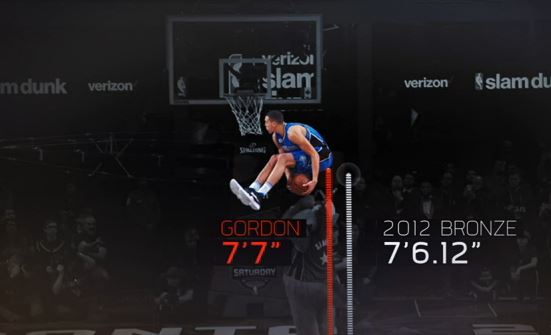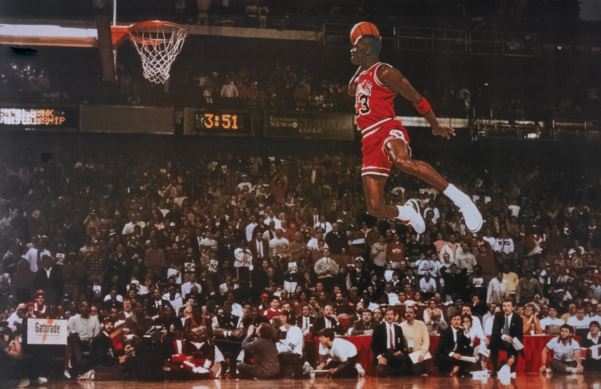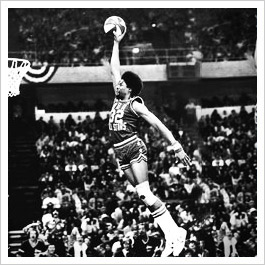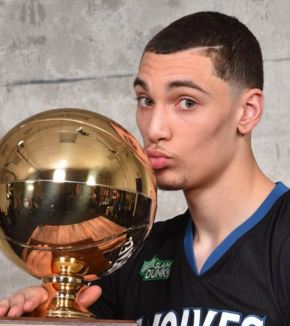 After as astoundingly entertaining slam dunk contest on All-Star Saturday, the NBA was again reminded that sometimes the best response to criticism is to ignore it. After the performances of Zach LaVine and Aaron Gordon, it is doubtful anyone will suggest the contest should be eliminated, or even slightly altered.
After as astoundingly entertaining slam dunk contest on All-Star Saturday, the NBA was again reminded that sometimes the best response to criticism is to ignore it. After the performances of Zach LaVine and Aaron Gordon, it is doubtful anyone will suggest the contest should be eliminated, or even slightly altered.
 But that could change as soon as next year. LaVine and Gordon established a standard that seems impossibly high to top. So if the next slam dunk is not as good as the last the slam dunk, someone will suggest eliminating it. And if the next two or three contests do not measure up, the criticism will increase. It will happen because it’s happened before.
But that could change as soon as next year. LaVine and Gordon established a standard that seems impossibly high to top. So if the next slam dunk is not as good as the last the slam dunk, someone will suggest eliminating it. And if the next two or three contests do not measure up, the criticism will increase. It will happen because it’s happened before.
The contest has a history that is so different from any other sporting event. Compare, for example, the slam dunk event to the game of basketball.
After Dr. James A. Naismith wrote the original 13 rules in 1891, the first basketball game was played in a gym in Springfield, Massachusetts. It lasted 30 minutes and exactly one basket was scored. That basket counted one point, so the final score was 1-0.
We don’t have any 1-0 games anymore.
The NBA’s slam dunk history actually began in the ABA in 1976, and the first contest was far more glamorous than the first basketball game. Consider the participants – Julius Erving, David Thompson, George Gervin, Larry Kenon and Artis Gilmore. If you’re counting, four of the five were eventually enshrined in the Hall of Fame.
 The first NBA contest eight years later also included four future Hall of Famers – Erving, Clyde Drexler, Dominique Wilkins and Ralph Sampson, although Sampson is in the Hall more for his college exploits. And the next year, Michael Jordan competed in the first of his three slam dunk events, so the standard established in the early years was also incredibly high.
The first NBA contest eight years later also included four future Hall of Famers – Erving, Clyde Drexler, Dominique Wilkins and Ralph Sampson, although Sampson is in the Hall more for his college exploits. And the next year, Michael Jordan competed in the first of his three slam dunk events, so the standard established in the early years was also incredibly high.
There were some good performances in the ’90s, but many of the star players chose not to participate and the event lost much of its appeal. That naturally led to criticism and although part of it was accurate, there really was little the league could do. If the best players refused to enter, the only option the league had was to invite the best dunkers who wanted to compete.
The criticism became so regular that the league finally responded by not having a slam dunk event during the 1998 All-Star Weekend in New York. The Saturday events were NBA-WNBA 2-ball, where an NBA and WNBA player teamed to shoot from designated places on the court; a rookie game and the 3-point shootout.
Madison Square Garden was silent most of the night. Within minutes after the events ended, league officials had decided to bring back the dunk contest. With the lockout of 1998-99, it did not re-emerge until 2000 in Oakland, where Vince Carter put on one of the greatest displays ever.
I once interviewed Michael Jordan about the history of the game and wrote an article for the NBA Encyclopedia. Jordan talked about how the game changes and used the dunk contest as an example.
 “I’ll give you a great example of the evolution of the game,” he said. “In the slam dunk contest, the major feat was to take off from the free throw line. Dr. J was the first to do it, then I did it. What was different about the way the two of us did it?”
“I’ll give you a great example of the evolution of the game,” he said. “In the slam dunk contest, the major feat was to take off from the free throw line. Dr. J was the first to do it, then I did it. What was different about the way the two of us did it?”
When I told him I had no clue, he said:
“When Dr. J took off, he ran. I dribbled, which is harder to do because you’ve got to get your rhythm together. People never even noticed that. That was my way of improving on what Dr J did. That was taking it to the next level – the evolution of the dunk. And then in the All-Star Game in 2000, Vince Carter took off with two hands from the free throw line. That’s the evolution of how change happens. Dr. J ran, I dribbled and Vince Carter is adding the two hands, which is increasing the norm.”
LaVine increased the norm on Saturday night. Twice, in fact. LaVine became the first player to take off from the foul line and windmill the dunk. And then he became the first to jump from the foul line and catch an alley oop pass for a dunk.
 Although Gordon did not dunk from the foul line, to write about the contest without marveling at the under-both-legs dunk would be wrong. Gordon matched LaVine dunk for spectacular dunk and those, including LaVine, who suggested the contest should have been a tie were correct.
Although Gordon did not dunk from the foul line, to write about the contest without marveling at the under-both-legs dunk would be wrong. Gordon matched LaVine dunk for spectacular dunk and those, including LaVine, who suggested the contest should have been a tie were correct.
Here’s betting that if that ever happens again, NBA commissioner Adam Silver will come out of the stands and stop it and there is a reason he should. The dunk is the only contest voted on by judges. The skills competition is decided by speed and accuracy and the 3-point contest is decided by shooting. The three judges who each gave Gordon a 9 on his final dunk made a mistake. They should have kept giving both players 50s, just because the two of them were so spectacular.
Something ironic and humorous has developed with the NBA All-Star Weekend. Despite the record 369 points the two teams scored on Sunday, the game has become boring. The Saturday events – including Karl-Anthony Towns becoming the first center to win the skills competition and the scintillating 3-point shootout by Klay Thomson and Steph Curry – were more exciting than the All-Star game on Sunday.
Maybe they should switch days.
MORE FROM HUBBARD:
REFLECTIONS ON PHIL AND KOBE .. AND THEIR DIFFERING PATHS
COACH FIRINGS PROVIDE HOPE FOR DAVID BLATT
WARRIORS ADD SILLINESS TO NBA SEASON
LeBRON’S FRIGHTENING REALITY
WHILE EXCELLING QUIETLY, SPURS MAY BE FINDING GEMS
TRUE FANTASY SPORTS STORY: WHEN LARRY BIRD GOT TRADED IN THE LARRY BIRD LEAGUE
Jan Hubbard has written about basketball since 1976 and worked in the NBA league office for eight years between media stints. Follow him on Twitter at @whyhub.